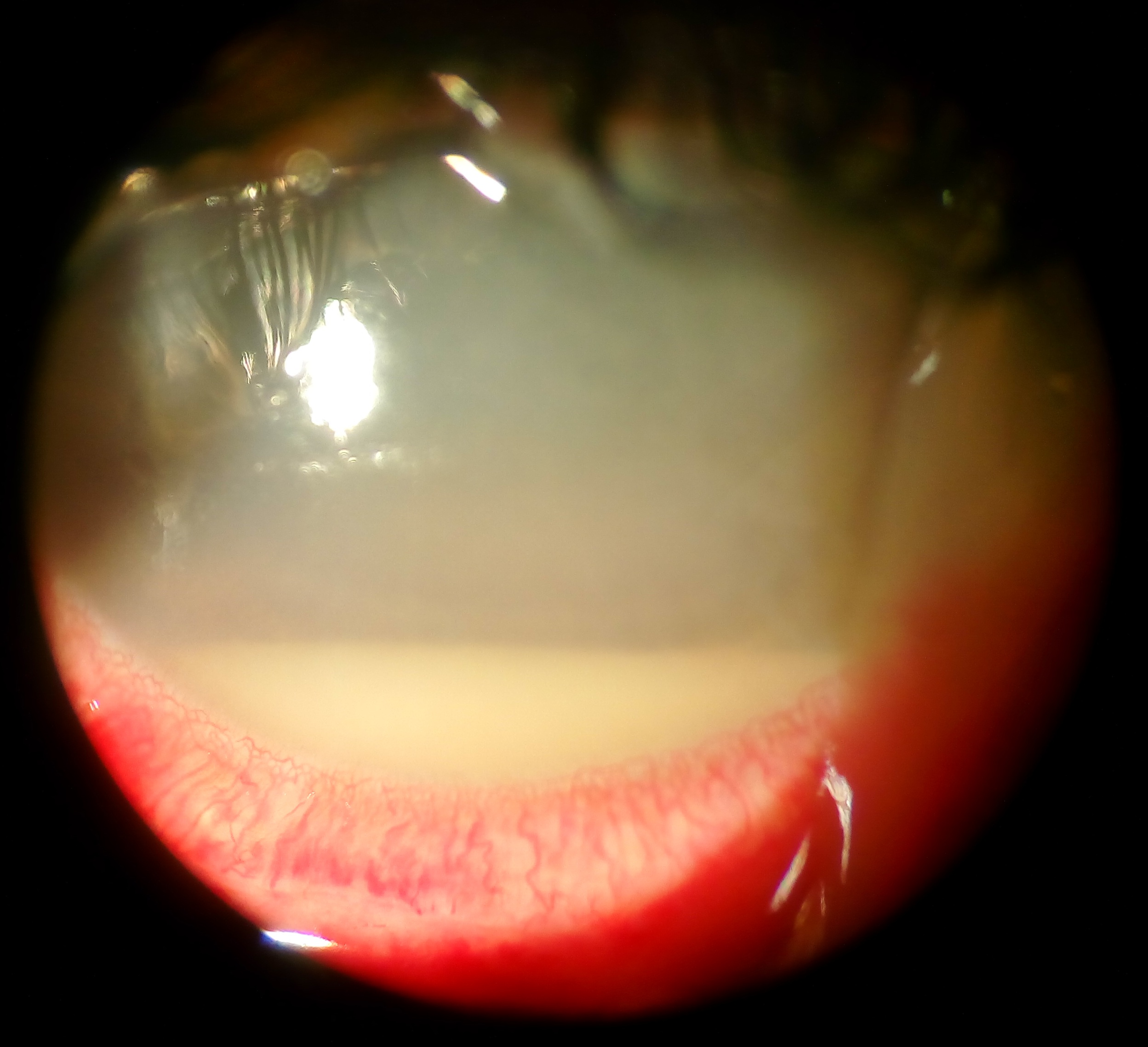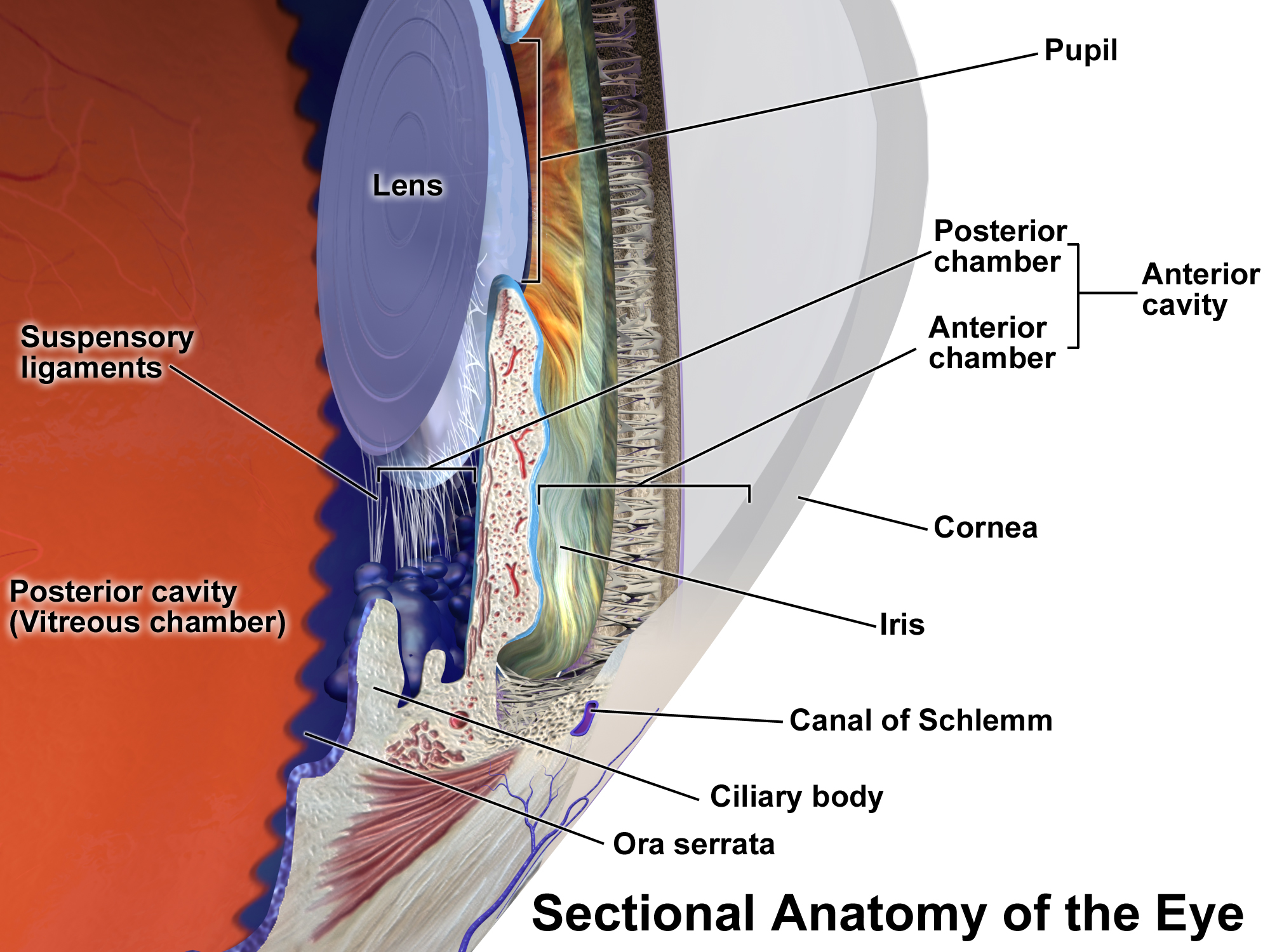|
Intravitreal
Intravitreal is a route of administration of a drug, or other substance, in which the substance is delivered into the vitreous humor of the eye. "Intravitreal" literally means "inside an eye". Intravitreal injections were first introduced in 1911 when Ohm gave an injection of air into the vitreous humor to repair a detached retina. In the mid-1940s, intravitreal injections became a standard way to administer drugs to treat endophthalmitis and cytomegalovirus retinitis. Epidemiology Intravitreal injections were proposed over a century ago however the number performed remained relatively low until the mid 2000s. Until 2001, intravitreal injections were mainly used to treat end-ophthalmitis. The number of intravitreal injections stayed fairly constant, around 4,500 injections per year in the US. The number of injections tripled to 15,000 in 2002 when triamcinolone injections were first used to treat diabetic macular oedema. This use continued to drive an increase to 83,000 injections ... [...More Info...] [...Related Items...] OR: [Wikipedia] [Google] [Baidu] |
Macular Edema
Macular edema occurs when fluid and protein deposits collect on or under the macula of the eye (a yellow central area of the retina) and causes it to thicken and swell ( edema). The swelling may distort a person's central vision, because the macula holds tightly packed cones that provide sharp, clear, central vision to enable a person to see detail, form, and color that is directly in the centre of the field of view. Cause The causes of macular edema are numerous and different causes may be inter-related. *It is commonly associated with diabetes. Chronic or uncontrolled diabetes type 2 can affect peripheral blood vessels including those of the retina which may leak fluid, blood and occasionally fats into the retina causing it to swell. *Age-related macular degeneration may cause macular edema. As individuals age there may be a natural deterioration in the macula which can lead to the depositing of drusen under the retina sometimes with the formation of abnormal blood vessels. *R ... [...More Info...] [...Related Items...] OR: [Wikipedia] [Google] [Baidu] |
Diabetic Retinopathy
Diabetic retinopathy (also known as diabetic eye disease), is a medical condition in which damage occurs to the retina due to diabetes mellitus. It is a leading cause of blindness in developed countries. Diabetic retinopathy affects up to 80 percent of those who have had both type 1 and type 2 diabetes for 20 years or more. In at least 90% of new cases, progression to more aggressive forms of sight threatening retinopathy and maculopathy could be reduced with proper treatment and monitoring of the eyes The longer a person has diabetes, the higher his or her chances of developing diabetic retinopathy. Each year in the United States, diabetic retinopathy accounts for 12% of all new cases of blindness. It is also the leading cause of blindness in people aged 20 to 64. Signs and symptoms Nearly all people with diabetes develop some degree of retina damage ("retinopathy") over several decades with the disease. For many, that damage can only be detected by a retinal exam, and has ... [...More Info...] [...Related Items...] OR: [Wikipedia] [Google] [Baidu] |
Ranibizumab
Ranibizumab, sold under the brand name Lucentis among others, is a monoclonal antibody fragment ( Fab) created from the same parent mouse antibody as bevacizumab. It is an anti-angiogenic that is approved to treat the "wet" type of age-related macular degeneration (AMD, also ARMD), diabetic retinopathy, and macular edema due to branch retinal vein occlusion or central retinal vein occlusion. Ranibizumab was developed by Genentech and marketed by them in the United States, and elsewhere by Novartis, under the brand name Lucentis. Ranibizumab (Lucentis) was approved for medical use in the United States in June 2006. Ranibizumab (Susvimo) was approved for medical use in the United States in October 2021. Medical uses In the United States, ranibizumab is indicated for the treatment of neovascular (wet) age-related macular degeneration, macular edema following retinal vein occlusion, diabetic macular edema, diabetic retinopathy, and myopic choroidal neovascularization. In the Europ ... [...More Info...] [...Related Items...] OR: [Wikipedia] [Google] [Baidu] |
Bevacizumab
Bevacizumab, sold under the brand name Avastin among others, is a medication used to treat a number of types of cancers and a specific eye disease. For cancer, it is given by slow injection into a vein (intravenous) and used for colon cancer, lung cancer, glioblastoma, and renal-cell carcinoma. In many of these diseases it is used as a first-line therapy. For age-related macular degeneration it is given by injection into the eye (intravitreal). Common side effects when used for cancer include nose bleeds, headache, high blood pressure, and rash. Other severe side effects include gastrointestinal perforation, bleeding, allergic reactions, blood clots, and an increased risk of infection. When used for eye disease side effects can include vision loss and retinal detachment. Bevacizumab is a monoclonal antibody that functions as an angiogenesis inhibitor. It works by slowing the growth of new blood vessels by inhibiting vascular endothelial growth factor A (VEGF-A), in other word ... [...More Info...] [...Related Items...] OR: [Wikipedia] [Google] [Baidu] |
Endophthalmitis
Endophthalmitis is inflammation of the interior cavity of the eye, usually caused by infection. It is a possible complication of all intraocular surgeries, particularly cataract surgery, and can result in loss of vision or loss of the eye itself. Infection can be caused by bacteria or fungi, and is classified as exogenous (infection introduced by direct inoculation as in surgery or penetrating trauma), or endogenous (organisms carried by blood vessels to the eye from another site of infection). Other non-infectious causes include toxins, allergic reactions, and retained intraocular foreign bodies. Intravitreal injections are a rare cause, with an incidence rate usually less than .05%. Signs and symptoms There is usually a history of recent eye surgery or penetrating trauma to the eye. Symptoms include severe pain, vision loss, and intense redness of the conjunctiva. Hypopyon can be present and should be looked for on examination by a slit lamp. It can first present with the 'blac ... [...More Info...] [...Related Items...] OR: [Wikipedia] [Google] [Baidu] |
Triamcinolone Acetonide
Triamcinolone acetonide, sold under the brand name Kenalog among others, is a synthetic corticosteroid medication used topically to treat various skin conditions, to relieve the discomfort of mouth sores, and by injection into joints to treat various joint conditions. It is also injected into lesions to treat inflammation in some parts of the body, particularly the skin. In nasal spray form, it is used to treat allergic rhinitis. It is used for the treatment of macular edema associated with uveitis. It is a more potent derivative of triamcinolone, and is about eight times as potent as prednisone. Most forms of triamcinolone acetonide are Prescription drug, prescription drugs. In 2014, the U.S. Food and Drug Administration (FDA) made triamcinolone acetonide an over-the-counter drug in the United States in nasal spray form under the brand name Nasacort. Medical uses Triamcinolone acetonide as an intra-articular injectable has been used to treat a variety of musculoskeletal ... [...More Info...] [...Related Items...] OR: [Wikipedia] [Google] [Baidu] |
Hypopyon
Hypopyon is a medical condition involving inflammatory cells in the anterior chamber of the eye. It is an exudate rich in white blood cells, seen in the anterior chamber, usually accompanied by redness of the conjunctiva and the underlying episclera. It is a sign of inflammation of the anterior uvea and iris, i.e. iritis, which is a form of anterior uveitis. The exudate settles at the dependent aspect of the eye due to gravity. It can be sterile (in bacterial corneal ulcer) or not sterile (fungal corneal ulcer). Differential diagnosis Hypopyon can be present in a corneal ulcer. It can occur as a result of Behçet's disease, endophthalmitis, panuveitis/panophthalmitis, or adverse reactions to some drugs (such as rifabutin). Hypopyon is also known as ''sterile pus'' because it occurs due to the release of toxins and not by the actual invasion of pathogens. The toxins secreted by the pathogens mediate the outpouring of leukocytes that settle in the anterior chamber of the eye. A ... [...More Info...] [...Related Items...] OR: [Wikipedia] [Google] [Baidu] |
Macular Degeneration
Macular degeneration, also known as age-related macular degeneration (AMD or ARMD), is a medical condition which may result in blurred or no vision in the center of the visual field. Early on there are often no symptoms. Over time, however, some people experience a gradual worsening of vision that may affect one or both eyes. While it does not result in complete blindness, loss of central vision can make it hard to recognize faces, drive, read, or perform other activities of daily life. Visual hallucinations may also occur. Macular degeneration typically occurs in older people. Genetic factors and smoking also play a role. It is due to damage to the macula of the retina. Diagnosis is by a complete eye exam. The severity is divided into early, intermediate, and late types. The late type is additionally divided into "dry" and "wet" forms with the dry form making up 90% of cases. The difference between the two forms is the change of macula. Those with dry form AMD have drusen, ce ... [...More Info...] [...Related Items...] OR: [Wikipedia] [Google] [Baidu] |
Aflibercept
Aflibercept, sold under the brand names Eylea and Zaltrap, is a medication used to treat wet macular degeneration and metastatic colorectal cancer. It was developed by Regeneron Pharmaceuticals and is approved in the United States and the European Union. It is an inhibitor of vascular endothelial growth factor (VEGF). Medical uses It is used for the treatment of wet macular degeneration and is administered as an intravitreal injection, that is, into the eye. For cancer treatment, is given intravenously in combination with the other cancer drugs 5-fluorouracil and irinotecan and the adjuvant folinic acid. On 27 August 2014, Eylea was also indicated for the treatment of people with visual impairment due to diabetic macular oedema, according to the updated summary of product characteristics. In May 2019 FDA expanded the indication for aflibercept to include all stages of diabetic retinopathy. Contraindications Eylea is contraindicated in patients with infections or active infla ... [...More Info...] [...Related Items...] OR: [Wikipedia] [Google] [Baidu] |
Route Of Administration
A route of administration in pharmacology and toxicology is the way by which a medication, drug, fluid, poison, or other substance is taken into the body. Routes of administration are generally classified by the location at which the substance is applied. Common examples include oral administration, oral and intravenous therapy, intravenous administration. Routes can also be classified based on where the target of action is. Action may be topical medication, topical (local), enteral administration, enteral (system-wide effect, but delivered through the gastrointestinal tract), or #Parenteral, parenteral (systemic action, but delivered by routes other than the GI tract). Route of administration and dosage form are aspects of drug delivery. Classification Routes of administration are usually classified by application location (or exposition). The route or course the active substance takes from application location to the location where it has its target effect is usually rather ... [...More Info...] [...Related Items...] OR: [Wikipedia] [Google] [Baidu] |
Uveitis
Uveitis () is inflammation of the uvea, the pigmented layer of the eye between the inner retina and the outer fibrous layer composed of the sclera and cornea. The uvea consists of the middle layer of pigmented vascular structures of the eye and includes the iris, ciliary body, and choroid. Uveitis is described anatomically, by the part of the eye affected, as anterior, intermediate or posterior, or panuveitic if all parts are involved. Anterior uveitis ( iridocyclytis) is the most common, with the incidence of uveitis overall affecting approximately 1:4500, most commonly those between the ages of 20-60. Symptoms include eye pain, eye redness, floaters and blurred vision, and ophthalmic examination may show dilated ciliary blood vessels and the presence of cells in the anterior chamber. Uveitis may arise spontaneously, have a genetic component, or be associated with an autoimmune disease or infection. While the eye is a relatively protected environment, its immune mechanisms ... [...More Info...] [...Related Items...] OR: [Wikipedia] [Google] [Baidu] |
Dexamethasone
Dexamethasone is a glucocorticoid medication used to treat rheumatic problems, a number of skin diseases, severe allergies, asthma, chronic obstructive lung disease, croup, brain swelling, eye pain following eye surgery, superior vena cava syndrome (a complication of some forms of cancer), and along with antibiotics in tuberculosis. In adrenocortical insufficiency, it may be used in combination with a mineralocorticoid medication such as fludrocortisone. In preterm labor, it may be used to improve outcomes in the baby. It may be given by mouth, as an injection into a muscle, as an injection into a vein, as a topical cream or ointment for the skin or as a topical ophthalmic solution to the eye. The effects of dexamethasone are frequently seen within a day and last for about three days. The long-term use of dexamethasone may result in thrush, bone loss, cataracts, easy bruising, or muscle weakness. It is in pregnancy category C in the United States, meaning that it should ... [...More Info...] [...Related Items...] OR: [Wikipedia] [Google] [Baidu] |




.jpg)

